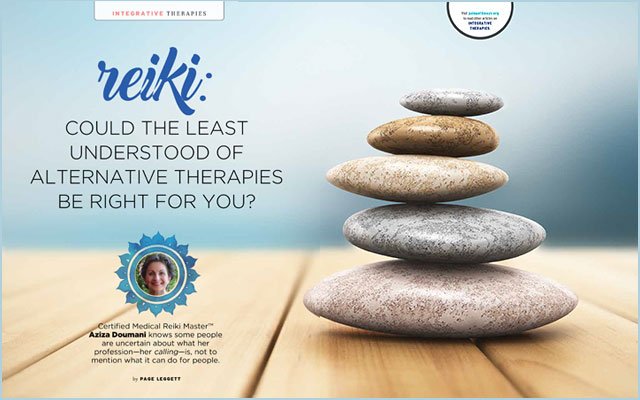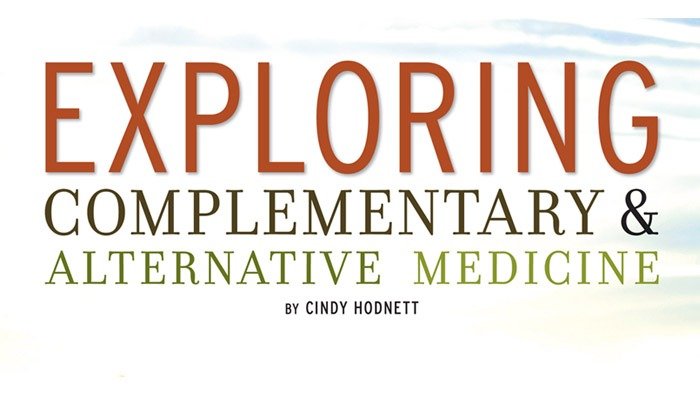Reiki

Certified Medical Reiki Master™ Aziza Doumani knows some people are uncertain about what her profession—her calling—is, not to mention what it can do for people.
There are people who hear the words “energy healer” and “life force” and are immediately skeptical. If you’re the sort who tunes out at the mention of “chi” or “qi”—both of which mean “life force” in Chinese—then you may feel the same way about Reiki. (“Ki” means “life force” in Japanese.) In India, it’s called “prana.” Many cultures practice the art (for it can’t be called a science) of energy healing. The United States has been slow to catch on.
“I don’t get referrals from doctors,” says Doumani, an Ellicott City, Maryland, Reiki practitioner. “My clients contact me on their own—either seeking Reiki as a last resort, or, having experienced Reiki, jumping on it immediately when their pain journey is in its infancy.”
But already, Reiki is used in the operating rooms at Columbia University Medical Center, not just as an integrative therapy. “It’s part of a unique Certified Medical Reiki Master™ program of elite Reiki masters accompanying patients as part of the surgical team during their surgeries,” says Doumani. There are only a couple hundred Certified Medical Reiki Masters in the world (Doumani included). “We’re experiencing much expansion, and it all began in Columbia’s OR.”
Reiki is also utilized at the world-renowned R. Adams Shock Trauma Center in Maryland, as well as Johns Hopkins Hospitals, and abundantly in palliative care centers because of its noted success in pain care. Reiki is a viable therapy for pain.
But Doumani doesn’t need a seal of approval from MDs. It’s enough for her to see the lives of her clients—she does not call them “patients”—transformed as a result of her healing hands.
“It’s the client who often ends up telling their doctor about Reiki,” says Doumani. “Depending on the doc, it’s met favorably or with rolled eyes. Reiki is experiencing a surge in medical settings, but some doctors and institutions are still resistant.
How it works
Science can’t explain why Reiki is effective. But Doumani can walk you through how a typical session works. The client lies down fully clothed on a massage table. The practitioner will position his or her hands on or just above the client’s body at different energy points and keep them in place for two to five minutes. This repeated action, Reiki practitioners say, charges energy fields with positive energy.
That’s it. It’s both as simple and mysterious as that.
“Every experience is different,” Doumani says. “Some people report that they see colors during a Reiki session. Others describe a tingly feeling. Some people think they feel my hands on one part of their body, but my hands aren’t actually anywhere close to the area they felt. Some even describe visions.”
And, she adds, “Some people feel nothing at all,” though feeling nothing doesn’t signify that the Reiki isn’t working. It simply means that a person doesn’t feel anything during the active session time. In fact, often after those exact sessions, the client experiences a release/response later on.
Some people feel benefit from just one Reiki session, but others require ongoing treatment. “Don’t expect Reiki to necessarily cure you in one session, though clients seeking help with chronic pain have had remarkable and immediate results in pain relief that they haven’t known in years. In one session.” In addition, Reiki can help reduce reliance on pain medications.
Doumani is careful to say that Reiki is not a substitute for going to a physician. It should be used in conjunction with other treatments, conventional and/or alternative, a point that Doumani always reiterates to her clients. She even requires them to sign a form attesting that they are not using Reiki as a substitute for medical care.
Skeptics and believers
Doctors may dismiss a patient’s belief in Reiki’s effectiveness. “It’s just the placebo effect,” they’ll say. Doumani has a response: “People help heal themselves all the time through positive thought. If that’s the placebo effect, then so be it.”
Although people don’t understand how Reiki works, it does work for many. You don’t even have to believe in it for it work, Doumani says. When used in conjunction with other therapies, it can help treat a host of ills, from depression to menopause and from addiction to anxiety. Says Doumani, “The physiological responses/benefits that occur from Reiki include its effect on the alpha and theta states for relaxation (meditative); stress reduction, healing and mental changes; activation of the parasympathetic nervous system (our rest-and-restore system); lower heart rate, lower pulse rate and slower breathing; and an overall nudging toward homeostasis. Clients report they experience shifts toward a positive mental attitude and toward feeling happier, offering them hope and a positive outlook. These are hallmarks of Reiki that we know exist—they’re real, measurable, and the reason people seek Reiki for physical and mental issues.”
Those who believe in the mind/body connection may have an easier time accepting Reiki. “Not all physical symptoms have physical origins,” Doumani says. She talks about the emotions associated with our internal organs—the liver is associated with anger, the lungs with grief—and how often she has found those emotions manifested with physical ailments.
We even use figures of speech that reference the body when talking about what causes us pain. “My job makes me sick to my stomach” is something we’ve all heard, or even said, before. Doumani also says that stress—from a bad job or other factors—can cause irritable bowel syndrome.
Another Doumani insight: You might say “I can’t stand this anymore” and unwittingly mean it literally. Knee pain can be brought on by stress … and would make it harder to stand.
Getting legit
Reiki is showing up more and more today at oncology centers across the country, including the Abramson Cancer Center at the University of Pennsylvania’s Penn Medicine in Philadelphia. The website tells patients: “Reiki has no contraindications; it is regarded as a completely safe and gentle practice. Reiki sessions are natural and holistic; there is no physical manipulation, nothing is ingested and nothing is applied to the skin.”
Orange Regional Medical Center in Middletown, New York, offers Reiki to its patients, too. It cites a list of conditions that Reiki may help, including relieving pain, reducing side effects from surgery and long-term illness and reducing stress and anxiety.
The Oncology Nursing Society’s (ONS) website lists three small-scale studies that examined Reiki’s efficacy. The results of one—“Biofield therapies and cancer-related symptoms: A review,” published in 2014 in the Clinical Journal of Oncology Nursing—showed promise, but there wasn’t a large enough study to produce conclusive results. From the ONC website: “Studies using biofield therapies for relief of pain, anxiety, fatigue and depression generally showed benefit; however, the evidence is not strong due to the limitations of the studies included.”
The National Institutes of Health reports that Reiki “hasn’t been shown to have any harmful effects” but that “little high-quality research has been done” to demonstrate if and how Reiki is effective.
Helping the body heal itself
Even though Reiki is beginning to gain wider acceptance, Doumani is used to encountering skeptics and doesn’t mind trying to gently educate them about the noninvasive practice that, she says, helps “elicit the body’s innate healing process.” She also knows Reiki isn’t for everyone, and she’s OK with that.
Enough people have found relief through Reiki—which Doumani calls a “gentle, loving and compassionate practice”—that she doesn’t mind being patient with naysayers. She understands that many MDs need hard evidence that a treatment works.
But some things can’t necessarily be explained. Many in the medical community turned up their noses at acupuncture, another holistic practice that can treat pain and other ailments until patients started extolling its benefits. Now, acupuncture is mainstream.
Acupuncture has been around since about 100 BC. Having originated in Japan in the 1920s, Reiki is the new kid on the block. It may take some time before the establishment recognizes it as a legitimate approach to pain.
Meanwhile, Reiki practitioners are pushing for more scientific studies that will prove what they know: Reiki is a safe, healing practice that can reduce pain, stress and anxiety. Until then, they’ll keep educating the doubters.
And reducing their clients’ pain and anxiety.
Avoiding shams and scams
Reiki is largely unregulated in the United States, so clients need to be vigilant when seeking a Reiki practitioner.
If you can’t find a hospital nearby that offers Reiki as part of its integrative medicine program, you may have to do some research. Ask friends for referrals. “I encourage clients to ask questions of a practitioner they’re considering,” Aziza Doumani says. “I always provide references from other clients and from colleagues. I want people to know about my level of integrity.”
Doumani and others are trying to standardize Reiki so that the real practitioners are discernable from the frauds. “There are people who do a mix-up/mash-up of different stuff and call it Reiki,” she says. “Clients can usually tell intuitively if they’re meeting with someone who’s legitimate or not.”
PainPathways Magazine
PainPathways is the first, only and ultimate pain magazine. First published in spring 2008, PainPathways is the culmination of the vision of Richard L. Rauck, MD, to provide a shared resource for people living with and caring for others in pain. This quarterly resource not only provides in-depth information on current treatments, therapies and research studies but also connects people who live with pain, both personally and professionally.
View All By PainPathways






